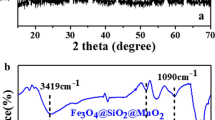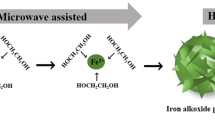Abstract
The Fe3O4@nSiO2@mSiO2/NTA (FNMs-NTA) was prepared by grafting magnetic mesoporous microspheres with nitrilotriacetic acid (NTA) and applied as an adsorbent for the removal of Cr(III) from complex solutions. Some characterization techniques including Brunauer–Emmett–Teller (BET), Fourier transform infrared spectrometer (FT-IR), X-ray diffraction (XRD), small-angle X-ray diffraction (SAXS), vibrating sample magnetometer (VSM), and thermal gravimetric analysis (TGA) were used to characterize functional groups and pore structure of FNMs-NTA, which proved that NTA was successfully decorated onto the magnetic Fe3O4@nSiO2@mSiO2 (FNMs) and FNMs-NTA featured a regular mesoporous structure. The batch adsorption of Cr(III) by FNMs-NTA exhibited high adsorption capacity (16.0 mg·g−1 at pH 3.0, and 25 °C). Adsorption data followed Freundlich isotherm and adsorption process was a spontaneous adsorption process. Moreover, the kinetics of adsorption were well explained by pseudo-second-order kinetic model. FNMs-NTA showed resistance to interfering inorganic cations (Na+, Ca2+) and complexing agents (EDTA). Furthermore, FNMs-NTA exhibited remarkable regeneration performance and easy separation under external magnetic field. X-ray photoelectron spectroscopy (XPS) analysis showed the FNMs-NTA had excellent adsorption ability for Cr(III) because of the ion exchange and surface complexation.













Similar content being viewed by others

Availability of data and materials
The data used and/or analyzed during the current study are available from the corresponding author on reasonable request.
References
An B, Lee H, Lee S, Lee S, Choi J (2015) Determining the selectivity of divalent metal cations for the carboxyl group of alginate hydrogel beads during competitive sorption. J Hazard Mater 298:11–18. https://doi.org/10.1016/j.jhazmat.2015.05.005
Bai C, Wang L, Zhu Z (2020) Adsorption of Cr(III) and Pb(II) by graphene oxide/alginate hydrogel membrane: characterization, adsorption kinetics, isotherm and thermodynamics studies. Int J Biol Macromol 147:898–910. https://doi.org/10.1016/j.ijbiomac.2019.09.249
Barakat MA (2011) New trends in removing heavy metals from industrial wastewater. Arabian J Chem 4:361–377. https://doi.org/10.1016/j.arabjc.2010.07.019
Budiana IGMN, Jasman J, Neolaka YAB, Riwu AAP, Elmsellem H, Darmokoesoemo H, Kusuma HS (2021) Synthesis, characterization and application of cinnamoyl C-phenylcalix[4]resorcinarene (CCPCR) for removal of Cr(III) ion from the aquatic environment. J Mol Liq 324:114776. https://doi.org/10.1016/j.molliq.2020.114776
Chen F, Hong M, You W, Li C, Yu Y (2015) Simultaneous efficient adsorption of Pb2+ and MnO4 ions by MCM-41 functionalized with amine and nitrilotriacetic acid anhydride. Appl Surf Sci 357:856–865. https://doi.org/10.1016/j.apsusc.2015.09.069
Cui L, Wang Y, Gao L, Hu L, Yan L, Wei Q, Du B (2015) EDTA functionalized magnetic graphene oxide for removal of Pb(II), Hg(II) and Cu(II) in water treatment: adsorption mechanism and separation property. Chem Eng J 281:1–10. https://doi.org/10.1016/j.cej.2015.06.043
Deng Y, Qi D, Deng C, Zhang X, Zhao D (2008) Superparamagnetic high-magnetization microspheres with an Fe3O4@SiO2 core and perpendicularly aligned mesoporous SiO2 shell for removal of microcystins. J Am Chem Soc 130:28–29. https://doi.org/10.1021/ja0777584
Duan W, Chen G, Chen C, Sanghvi R, Iddya A, Walker S, Liu H, Ronen A, Jassby D (2017) Electrochemical removal of hexavalent chromium using electrically conducting carbon nanotube/polymer composite ultrafiltration membranes. J Membr Sci 531:160–171. https://doi.org/10.1016/j.memsci.2017.02.050
Hao X, Tao E, Yang S, Li Y (2021) A new montmorillonite-based porous composites: effectively removal of Cr(III)-organic complexes in tannery wastewater. J Polym Environ. https://doi.org/10.1007/s10924-021-02193-4
Huang J, Ye M, Qu Y, Chu L, Chen R, He Q, Xu D (2012) Pb (II) removal from aqueous media by EDTA-modified mesoporous silica SBA-15. J Colloid Interface Sci 385:137–146. https://doi.org/10.1016/j.jcis.2012.06.054
Iqbal S, Yun JI (2017) EDTA-functionalized mesoporous silica for the removal of corrosion products: adsorption studies and performance evaluation under gamma irradiation. Micropor Mesopor Mater 248:149–157. https://doi.org/10.1016/j.micromeso.2017.04.028
Javed HS, Zahir K, Abdul A, Atif S, Mansha M (2018) Adsorption of mordant red 73 dye on acid activated bentonite: kinetics and thermodynamic study. J Mol Liq 254:398–405. https://doi.org/10.1016/j.molliq.2018.01.100
Jiraroj D, Unob F, Hagège A (2006) Degradation of Pb–EDTA complex by a H2O2/UV process. Water Res 40:107–112. https://doi.org/10.1016/j.watres.2005.10.041
Juang R, Ju C (1997) Equilibrium sorption of Copper(II)−ethylenediaminetetraacetic acid chelates onto cross-linked, polyaminated chitosan beads. Ind Eng Chem Res 36:5403–5409. https://doi.org/10.1021/ie970322k
Lim S, Zheng Yu, Zou S, Chen JP (2008) Characterization of copper adsorption onto an alginate encapsulated magnetic sorbent by a combined FT-IR, XPS, and mathematical modeling study. Environ Sci Technol 42:2551. https://doi.org/10.1021/es7021889
Liu L, Liu J, Lu Z, Yang Z, Lv C, Xue J, Tang A (2019) Synthesis and characterization of magnetic Fe3O4@CaSiO3 composites and evaluation of their adsorption characteristics for heavy metal ions. Environ Sci Pollut Res Int 26:8721–8736. https://doi.org/10.1007/s11356-019-04352-6
Liu W, Zeng F, Jiang H, Zhang X (2011) Adsorption of lead (Pb) from aqueous solution with Typha angustifolia biomass modified by SOCl2 activated EDTA. Chem Eng J 170:21–28. https://doi.org/10.1016/j.cej.2011.03.020
Liu Y, Fu R, Sun Y, Zhou X, Baig SA, Xu X (2016) Multifunctional nanocomposites Fe3O4@SiO2-EDTA for Pb(II) and Cu(II) removal from aqueous solutions. Appl Surf Sci 369:267–276. https://doi.org/10.1016/j.apsusc.2016.02.043
Liu Y, Lou Z, Sun Y, Zhou X, Baig SA, Xu X (2017) Influence of complexing agent on the removal of Pb(II) from aqueous solutions by modified mesoporous SiO2. Micropor Mesopor Mater 246:1–13. https://doi.org/10.1016/j.micromeso.2017.03.005
Manos MJ, Kanatzidis MG (2016) Metal sulfide Ion exchangers: superior sorbents for the capture of toxic and nuclear waste-related metal ions. Chem Sci 7:4804–4824. https://doi.org/10.1002/chin.201638242
Mehta D, Mazumdar S, Singh SK (2015) Magnetic adsorbents for the treatment of water/wastewater—a review. Journal of Water Process Engineering 7:244–265. https://doi.org/10.1016/j.jwpe.2015.07.001
Meunier N, Drogui P, Montané C, Hausler R, Mercier G, Blais JF (2006) Comparison between electrocoagulation and chemical precipitation for metals removal from acidic soil leachate. J Hazard Mater 137:581–590. https://doi.org/10.1016/j.jhazmat.2006.02.050
Mohan D, Singh KP, Singh VK (2006) Trivalent chromium removal from wastewater using low cost activated carbon derived from agricultural waste material and activated carbon fabric cloth. J Hazard Mater 135:280–295. https://doi.org/10.1016/j.jhazmat.2005.11.075
Pan J, Jiang J, Xu R (2013) Adsorption of Cr(III) from acidic solutions by crop straw derived biochars. J Environ Sci 25:1957–1965. https://doi.org/10.1016/S1001-0742(12)60305-2
Pastora JG, Bringas E, Ortiz I (2014) Recent progress and future challenges on the use of high performance magnetic nano-adsorbents in environmental applications. Chem Eng J 256:187–204. https://doi.org/10.1016/j.cej.2014.06.119
Ren Y, Abbood HA, He F, Peng H, Huang K (2013) Magnetic EDTA-modified chitosan/SiO2/Fe3O4 adsorbent: preparation, characterization, and application in heavy metal adsorption. Chem Eng J 226:300–311. https://doi.org/10.1016/j.cej.2013.04.059
Repo E, Warchoł JK, Bhatnagar A, Sillanpää M (2011) Heavy metals adsorption by novel EDTA-modified chitosan–silica hybrid materials. J Colloid Interface Sci 358:261–267. https://doi.org/10.1016/j.jcis.2011.02.059
Repo E, Warchoł JK, Bhatnagar A, Mudhoo A, Sillanpää M (2013) Aminopolycarboxylic acid functionalized adsorbents for heavy metals removal from water. Water Res 47:4812–4832. https://doi.org/10.1016/j.watres.2013.06.020
Sillanpää MET, Agustiono Kurniawan T, Lo W (2011) Degradation of chelating agents in aqueous solution using advanced oxidation process (AOP). Chemosphere 83:1443–1460. https://doi.org/10.1016/j.chemosphere.2011.01.007
Singh D, Verma S, Gautam RK, Krishna V (2015) Copper adsorption onto synthesized nitrilotriacetic acid functionalized Fe3O4 nanoparticles: kinetic, equilibrium and thermodynamic studies. J Environ Chem Eng 3:2161–2171. https://doi.org/10.1016/j.jece.2015.07.020
Szalinska E, Dominik J, Vignati DAL, Bobrowski A, Bas B (2010) Seasonal transport pattern of chromium(III and VI) in a stream receiving wastewater from tanneries. Appl Geochem 25:116–122. https://doi.org/10.1016/j.apgeochem.2009.11.002
Tu J, Boyle AL, Friedrich H, Bomans P, Bussmann J, Sommerdijk N, Jiskoot W, Kros A (2016) Mesoporous silica nanoparticles with large pores for the encapsulation and release of proteins. ACS Appl Mater Interfaces 8:32211–32219. https://doi.org/10.1021/acsami.6b11324
Vilardi G, Di Palma L, Verdone N (2018) On the critical use of zero valent iron nanoparticles and Fenton processes for the treatment of tannery wastewater. Journal of Water Process Engineering 22:109–122. https://doi.org/10.1016/j.jwpe.2018.01.011
Wang J, Zheng S, Liu J, Xu Z (2010) Tannic acid adsorption on amino-functionalized magnetic mesoporous silica. Chem Eng J 165:10–16. https://doi.org/10.1016/j.cej.2010.08.066
Wang J, Atif S, Zhang D (2020a) Adsorption of Cr(III) by EGTA modified magnetic microsphere: effect of high salinity and organic chelating acids. Environ Technol Innovation 20:101088. https://doi.org/10.1016/j.eti.2020.101088
Wang J, Tong X, Chen Y, Sun T, Wang C (2020b) Enhanced removal of Cr(III) in high salt organic wastewater by EDTA modified magnetic mesoporous silica. Micropor Mesopor Mater 303:110262. https://doi.org/10.1016/j.micromeso.2020.110262
Wang T, Liu W, Xiong L, Xu N, Ni J (2013) Influence of pH, ionic strength and humic acid on competitive adsorption of Pb(II), Cd(II) and Cr(III) onto titanate nanotubes. Chem Eng J 215–216:366–374. https://doi.org/10.1016/j.cej.2012.11.029
Wang T, Jin X, Chen Z, Megharaj M, Naidu R (2014) Simultaneous removal of Pb(II) and Cr(III) by magnetite nanoparticles using various synthesis conditions. J Ind Eng Chem 20:3543–3549. https://doi.org/10.1016/j.jiec.2013.12.047
Wang Z, Jia Y, Song W, Li X, Xu K, Wang Z (2021) Optimization of boron adsorption from desalinated seawater onto UiO-66-NH2/GO composite adsorbent using response surface methodology. J Clean Prod 300:126974. https://doi.org/10.1016/j.jclepro.2021.126974
Wu X, Cobbina SJ, Mao G, Xu H, Zhang Z, Yang L (2016) A review of toxicity and mechanisms of individual and mixtures of heavy metals in the environment. Environ Sci Pollut Res 23:8244–8259. https://doi.org/10.1007/s11356-016-6333-x
Yang P, Quan Z, Hou Z, Li C, Kang X, Cheng Z, Lin J (2009) A magnetic, luminescent and mesoporous core–shell structured composite material as drug carrier. Biomaterials 30:4786–4795. https://doi.org/10.1016/j.biomaterials.2009.05.038
Zaidi N, Lim L, Usman A (2018) Artocarpus odoratissimus leaf-based cellulose as adsorbent for removal of methyl violet and crystal violet dyes from aqueous solution. Cellulose 25:1–13. https://doi.org/10.1007/s10570-018-1762-y
Zhang G, Chen D, Zhao W, H, Wang, L, T, (2016) A novel D2EHPA-based synergistic extraction system for the recovery of chromium (III). Chem Eng J 302:233–238. https://doi.org/10.1016/j.cet.2016.05.063
Zhang X, Huang P, Zhu S, Hua M, Pan B (2019) Nanoconfined hydrated Zirconium oxide for selective removal of Cu(II)-carboxyl complexes from high-salinity water via ternary complex formation. Environ Sci Technol 53:5319–5327. https://doi.org/10.1021/acs.est.9b00745
Zhao C, Chen W (2019) A review for tannery wastewater treatment: some thoughts under stricter discharge requirements. Environ Sci Pollut Res 26:26102–26111. https://doi.org/10.1007/s11356-019-05699-6
Zheng J, Feng H, Lam MH, Lam PK, Ding Y, Yu H (2009) Removal of Cu(II) in aqueous media by biosorption using water hyacinth roots as a biosorbent material. J Hazard Mater 171:780–785. https://doi.org/10.1016/j.jhazmat.2009.06.078
Zou X, Pan J, Ou H, Wang X, Guan W, Li C, Yan Y, Duan Y (2011) Adsorptive removal of Cr(III) and Fe(III) from aqueous solution by chitosan/attapulgite composites: Equilibrium, thermodynamics and kinetics. Chem Eng J 167:112–121. https://doi.org/10.1016/j.cej.2010.12.009
Funding
We are thankful for the financial supports provided by National Natural Science Foundation of China (22076111,21677092), and also thankful for the Basic Research Program Funded by Wenzhou (S20180009), China.
Author information
Authors and Affiliations
Contributions
LL did some of adsorption experiments, analyzed the data, and edited the manuscript; JW conceived the research, edited the manuscript, and supervised the project; XT did some of adsorption experiments, and reviewed the manuscript; SZ did data curation, and reviewed the manuscript.
Corresponding author
Ethics declarations
Ethics approval and consent to participate
Not applicable.
Consent for publication
Not applicable.
Competing interests
The authors declare no competing interests.
Additional information
Responsible Editor: Tito Roberto Cadaval Jr.
Publisher's note
Springer Nature remains neutral with regard to jurisdictional claims in published maps and institutional affiliations.
I have not submitted my manuscript to a preprint server before submitting it to Environmental Science and Pollution Research.
Rights and permissions
About this article
Cite this article
Liang, L., Wang, J., Tong, X. et al. Enhanced adsorptive removal of Cr(III) from the complex solution by NTA-modified magnetic mesoporous microspheres. Environ Sci Pollut Res 29, 45623–45634 (2022). https://doi.org/10.1007/s11356-022-19039-8
Received:
Accepted:
Published:
Issue Date:
DOI: https://doi.org/10.1007/s11356-022-19039-8



